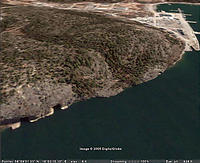June 30, 2005
Happy About Gene Testing
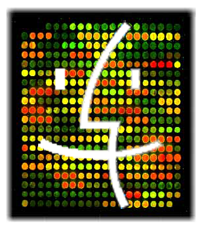 This week's CNE health post is about patient's emotional reactions to gene testing. A common concern is that if people are allowed to test themselves for genetic disorders they will get depressed and passivised if they find out that they are at risk. But a new study shows that people take such bad news well, at least in the case of the Alzheimer risk factor ApoE4. Not only are depression and anxiety indices the same for the tested and non-tested people, but they are overall positive to the testing and adjust their long-term insurance to reflect their new knowledge.
This week's CNE health post is about patient's emotional reactions to gene testing. A common concern is that if people are allowed to test themselves for genetic disorders they will get depressed and passivised if they find out that they are at risk. But a new study shows that people take such bad news well, at least in the case of the Alzheimer risk factor ApoE4. Not only are depression and anxiety indices the same for the tested and non-tested people, but they are overall positive to the testing and adjust their long-term insurance to reflect their new knowledge.
Of course, a lot depends on how the results are presented. Another study (Senior V, Marteau TM, Peters TJ., Will genetic testing for predisposition for disease result in fatalism? A qualitative study of parents responses to neonatal screening for familial hypercholesterolaemia. Soc Sci Med. 1999 Jun;48(12):1857-60.) of familial hypercholesterolaemia (FH), an inherited predisposition to heart disease, showed that parents to children testing positive for FH took the news better when they saw it as an increase in cholesterol levels (familiar, something that can be controlled through diet) than as something genetic (unfamiliar, unchangeable). In fact, a study (that I can't find for the moment) demonstrated that in the case of a certain lung disorder, test results from a child phrased so that they appeared abstract or immutable caused parents to smoke more as a stress reaction! Clearly much work has to be done on how to present results to get maximum health benefits.
The positive attitudes to testing for Alzheimer risk seems to fit with previous studies such as Public attitudes about genetic testing for Alzheimer's disease by P.J. Neumann et al. (Health Affairs, Vol 20, Issue 5, 252-264) where 79% of the respondents said they would take a genetic test to predict whether they would eventually develop the disease. An interesting observation was that people were just half as likely to want a test with 10% chance of being incorrect - people clearly expect genetic testing to be very definitive. Being family or friend with someone affected by the illness also increases the positiveness to testing.
If we can only avoid people holding too much faith in gene tests and the view that genes tell the future, widespread genetic testing - either done as part of normal healthcare or privately - has a good chance of helping overall health. Problems can be diagnosed early or people can keep a look for them, lifestyles and investment can be adjusted to suit one's likely health future. The big losers would be insurance companies legally prevented from knowing what the clients know, and socialised health care systems that gets more and more diagnosed cases.
I Can See My House From here!
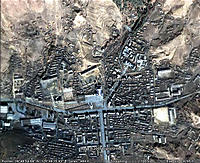 A while back I raved about Worldwind. Now I have Google Earth to rave about.
A while back I raved about Worldwind. Now I have Google Earth to rave about.
This is Google's competitor/clone of WorldWind, and it is a good competitor. They both offer similar things but in slightly different ways.
 Google Earth is not as dependent on advanced ActiveX as worldwind, but on start it always suggests that I use it instead of the OpenGL that I need on my Matrox card. Making the wrong choice means I have to do a restart of the program and reload the cache again.
Google Earth is not as dependent on advanced ActiveX as worldwind, but on start it always suggests that I use it instead of the OpenGL that I need on my Matrox card. Making the wrong choice means I have to do a restart of the program and reload the cache again.
The interface is fairly natural. I found most controls fairly obvious, although the tilt and orientation adjustment controls were a bit sluggish - it is nice to get a feeling of momentum, but sometimes it can be too much.
 The images used in Google is often not as high qualityas the NASA images. They seem pale, busy and blotchy (compare the arid hot beauty of Worldwind's Sahara with the sandy blotches of Google Earth). Much of this is simple aesthetics and choice of color filters, but often the patches of high density images pollute the appearance from afar and make it harder to make our contours. Close up Google's maps often include too much clouds (bad for use as an atlas, but sometimes quite beautiful in itself).
The images used in Google is often not as high qualityas the NASA images. They seem pale, busy and blotchy (compare the arid hot beauty of Worldwind's Sahara with the sandy blotches of Google Earth). Much of this is simple aesthetics and choice of color filters, but often the patches of high density images pollute the appearance from afar and make it harder to make our contours. Close up Google's maps often include too much clouds (bad for use as an atlas, but sometimes quite beautiful in itself).
 But Google has wonderfully detailled images of many non-US cities. The title of this post is literally true, but I can even see the roofing on my window on the image (it is the next-to-uppermost white rectangle on the right side of the roof of the center building). This makes it even more fun for an European like me. I can look around naval bases in the Stockholm archipelago or explore the Karst landscape east of Treiste. Some important cities are missing, like the inexplicable lack of hi res pictures of Brussels, but that will hopefully be fixed in the near future.
But Google has wonderfully detailled images of many non-US cities. The title of this post is literally true, but I can even see the roofing on my window on the image (it is the next-to-uppermost white rectangle on the right side of the roof of the center building). This makes it even more fun for an European like me. I can look around naval bases in the Stockholm archipelago or explore the Karst landscape east of Treiste. Some important cities are missing, like the inexplicable lack of hi res pictures of Brussels, but that will hopefully be fixed in the near future.
The layering is much more versatile than in Worldwind, although most markers (lodging, ATMs, pharmacies) are mostly useful for americans. The 3D building layer feature is fun, although I wonder how useful it is - yet. Here is where I think the creativity of users in coming up with interesting things to mark and new layers will come into its most. The sheer momentum of the Google empire is likely to help this take off.
Both programs eat processor power, memory and other system resources. I'd like a program that was something that could hide in the background better. Growing up surrounded by maps, I have always had the need to have an atlas handy to check things. But calling up these programs is like putting my father's heaviest folio atlas on the table.
Overall, I think both programs are excellent starts in making a geographical user interface for displaying all sorts of located data. What I would wish for in Google Globe is more useful location labels (they appear rather slowly and at low camera height) and perhaps a pure map layer. WorldWind would probably benefit from having the potentially huge user base Google can drum up, and the potential income from the Plus version.
June 28, 2005
Designer Babies of the Midsummer Night
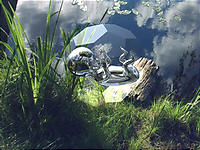 As I briefly mentioned last entry, I participated in a television debate about designer babies the June 23 in the program Sommardebatt. The program can be viewed online, I'm in the second segment debating with Chatrine Pålsson (kd). The debate was recorded on a boat during a beautiful midsummer night in Umeå.
As I briefly mentioned last entry, I participated in a television debate about designer babies the June 23 in the program Sommardebatt. The program can be viewed online, I'm in the second segment debating with Chatrine Pålsson (kd). The debate was recorded on a boat during a beautiful midsummer night in Umeå.
The origin of the debate was the recent decision by the health care of Västra Götaland to fund a trip to Belgium in order to help a couple get a child that was free of a genetic immune deficiency disease, so that the younger sibling could help the older by donated stem cells. The reason for the trip abroad was that Swedish laws are unclear on the subject. Is this an instrumentalisation of the poor child, or just a good way of helping a family?
My position is of course pro-screening. Using preimplantory screening to avoid diseases is good regardless of any siblings that might be helped: the child will have at least one bad thing less to worry about once it is born.
But what about instrumentalisation? It seems unlikely the parents only cares for the older child and solely see the sibling as a medical tool. To go through with IVF, PGD and a pregnancy one has to want a child rather dearly.
In this case I guess the donation is mostly stem cells from the umbilical cord, so there is no real problems about interfering with the baby. But the social pressures involved in sibling donations can be rather frightening. Who can say no when asked to undergo potentially very painful treatments to help save a sibling? (there was a rather melodramatic CSI episode about this) But this is not a strong argument to ban conceiving potential donor siblings (just for giving some councelling, perhaps). First, one could always try to have a child the normal way, which would again put a child in this hard situation (and if the new child was also sick, likely produce a sense of resentment). Second, if one thinks that these psychological risks are great enough to try to prevent children from being born into these circumstances, then logically one should also try to prevent other children from being born into circumstances potentially as bad or worse: parents addicted to drugs, parents with psychological problems, parents in tense social situations etc. Clearly that goes against the generally accepted rule that people are allowed to have children freely and that governments shouldn't intervene into pregnancies.
One could of course argue that it is not the conception per se that should be banned, but the act of doing the PGD for this purpose. It is an active act rather than passively letting a pregnancy happen.
This ties in with the issue of whether tax money should go to this kind of treatment. If one accepts tax funded medicine, then there will always be a problem that some treatments are seen by some as unethical, be they abortions, transplants or stem cells. And since societal consensus is unlikely to ever be total in some of these issues, there are always people being forced to pay for immoral acts. It must be rather horrific for an anti-abortion person to know his tax money goes to finance murder, as he sees it. My own libertarian position of course has no problem here: tax money should not in general go to medical treatments, they should be paid for by insurance systems instead.
On the moral side, I'm convinced PGD is such a good thing that it should be allowed. And this brings us in to the core issues of the debate: the nature of pre-persons and human dignity. Because that is really where both Chatrine and me wanted to go in the program.
The pre-person issue is in my opinion not an issue: everything quintessentially human about a human comes from having a working complex nervous system: the ability to be conscious, to experience sensations, to act, to think, to learn and to make morally informed decisions. An embryo is not a person, but it can become one in time. This means one should treat it carefully if one intends that a person should come into being, but not that it by its nature is sacred.
The opposing view usually is expressed in terms of souls, which usually just seem to consist of untestable handwaving. If one accepts it, then one ends up in the uneviable position of explaining why not people are doing what they can to save the majority of embryos that never attach in the utreus naturally - these are, by assumption, doomed ensouled beings. Just standing by and condoning their deaths would be just as bad as not helping sick children.
There are smarter versions of the embryo-as-person argument, but space and time are limited here for the moment, so let's skip on to human dignity. But it is important to note that the above differences in view are deep philosophical differences that cannot really be resolved by empirical facts; society will always contain those who hold one or the other position, and a total consensus will not happen. One side could impose its will on the other, but it would not be moral to do so from the perspective of a pluralistic liberal democratic view of society.
Chaterine expressed worry about where these developments are taking us. To her, we are sliding down a slippery slope towards a degradation of human dignity. I think the reverse: we are becoming better at achieving human dignity.
Again the difference lies in philosophical outlook. My view is basically Mirandolian: the essentially human, that which gives us our dignity, is our ability to change and improve ourselves - both individually and as a species. We are free. As long as modifications give children greater freedom to live their lives they are acceptable and good: freedom from diseases increase life chances, as does longer life, higher intelligence and so on. This is basically Ronald Bailey's "would a reasonable person consent to having particular genetic traits or not? approach to deciding ethicality.
Opposed to this is the view that people are more things than processes, that there is a natural (or divine) order that one shouldn't contradict. Sometimes it is expressed secularly as the idea that it is better to have a random genome than a selected one. But this is a very weak argument, as demonstrated (again) by Ronald . Further, even if I could control every gene in an embryo, it wouldn't give me control over the person that emerges. While I could certainly bias him or her in different ways, the unfolding of the mind is deeply uncontrollable: a chaotic interaction between genes, environment, randomness and the emerging person's own decisions. Designer children would be as unpredictable as ordinary children, and parents hoping to get a very particular result are bound to be disappointed. But the solution to that is again not banning the designer children, but to give people reasonable expectations.
But the above secular argument is not really a core argument. I usually find that people hold a deeper worldview that just tries to express itself in accepted secular manners. The natural/divine order is the emotional core, and it won't go away. But it is also a particular worldview, not a moral absolute: one cannot base societal rules on it unless it is very widely accepted. Which it isn't; it is a common view, but unfalsifiable and in the end religious, and there are opposing worldviews. Hence society must take a neutral position and accept that some will challenge the natural order and others won't.
Chatrine constantly talked about the need to problematise scientific advancements and have a broader public debate. While I think she used problematise in a far too negative sense, I agree about the public debate. But that needs to go beyond the typical Swedish assumption that deep down we all agree. I think it is not true: deep down we all disagree. But that doesn't mean we can't have a civil discussion about it in the bright summer nights.
June 21, 2005
Celebrating Creativity... and Intellectual Property?
 As I mentioned before I'm of somewhat two minds on patents, especially software patents. The aim of the patent system (and IP in general) is to maximise the incentives to be creative and implement good ideas, but it can also hinder and block them. As usual in unclear but important situations people tend to polarize: we are living in an age of IP dualism and demands for orthodoxy.
As I mentioned before I'm of somewhat two minds on patents, especially software patents. The aim of the patent system (and IP in general) is to maximise the incentives to be creative and implement good ideas, but it can also hinder and block them. As usual in unclear but important situations people tend to polarize: we are living in an age of IP dualism and demands for orthodoxy.
The June 20 decision by the EU Parliament's Legal Affairs Committee not to accept the amendments to the patent directive that would hinder patents of pure software will likely lead to a parliament decision in favor of software patents next month. I had the chance to attend the European Innovation Day in Brussels, "a celebration of European Intellectual Property and Creativity" by the European Industry on june 22. So how does the industry view the situation, and will it be any good for people in general?
(This is version 1.0 of this entry; due to a television appearance I will finish it tomorrow)
Can you own everything?
The first thing that hit me was the new EU abbreviation CII: Computer Implemented Inventions. For some reason I absolutely hate it. Most inventions today involve computers somewhere, if only in the design process. CII is more specific: devices that contain computers doing something - i.e. software. But due to the parliamentary process the bill first talked about "patentability of computer-aided inventions", then about "computer-controlled inventions" and then the industry prefereed CII. The real source of mud is of course the key issue of whether software is something material - possible to handle as any other invention, or something immaterial, in need of its own unique rules (or lack of rules). One often heard view is that software (or information in general) is immaterial and hence cannot be owned.
But being someone's property is not a physical state of a thing. If the ownership of an object changes, nothing changes in the object or its relationship with other physical objects. What changes is how it is perceived by a group of humans, who now regard it as property of person B rather than A. This might be deeper than merely a social construction, it could well tie in with ancient and strong territorial routines in the cellars of our minds. But property exists as mental "software" (or more properly, data). And this software/data can relate not just to present physical objects (my computer), but to not-yet-existing objects (the books I ordered), processes (my vacation), loosely physical objects as software (my graph program) and nonphysical objects such as ideas (my proof of the Goldbach conjecture). In principle there is nothing that cannot be made the focus of our property-thinking. All these things hold value (judged subjectively by me and other valuators) and we can manipulate their state as property by social agreement. Not all kinds of property are the same; a few have moral limitations (like owning people), and many kinds of property have practical properties that influence how they can be handled: the rules about owning a computer are different from the rules about owning land or owning software. But there is nothing inherent about software saying it cannot be owned in some suitable sense; the real discussion is rather what schemes we should use to handle it.
One of the speakers, professor Philippe Simmonot, extended this argument in an excellent whitepaper that criticised both the consequentialist arguments for or against software patents. It also points out that we already have a de facto software patents in the EU despite the Munich convention, and finally suggests that due to basic economic arguments and the appropriability of software it should by its nature be patentable. Even if one disagrees with his conclusions it is a relevant paper.
But Simonnot was very much a minority at the meeting, since the dominant perspective was a pragmatic political-economical one with no intention to go into the details of software patentability, changing the Munich convention etc. Hence the focus on CII: as long as the software is seen as an integral part of a device, rather than a separate thing embedded into it. This makes the software inseparable from the device, and hence patentable.
Europe is great at this ubiquitious kind of systems, but it should be noted that more hardware independent software is a huge and important market - where Europe lags behind quite notably compared the the US software industry. Now, if software patents are such competition- and innovation-killers as is often argued, it is strange that the US software industry is doing so well (both in terms of market, innovation and number of players), especially compared to the European software industry that did not have software patents.
Celebrating Creativity
Creativity consists of either creating something entirely new, or combining existing things in a new way. IP doesn’t apply to the first, unless it is insufficiently new (a good incentive of being really creative) or misapplied (good incentive to improve the IP regime). The second form of creativity can be helped and hindred by IP – if it is hard to combine things because they are overly protected creativity suffers, but if people are stimulated to reveal what they have invented and make it available for further use, then creativity is enhanced.
Striking the Balance
IP of any kind is always a balance between these problems. The same debate recurs from its inception. Abraham Lincoln's classic quote "the patent system added the fuel of interest to the fire of genius" recurred again and again. At the same time, there are other fuels too. The fuel of interest in free or open software is curiosity, aesthetics, perceived need and the wish to contribute – an alternative fuel, but in many applications insufficient. There are few people so interested or dedicated that they try to write free supply chain management software.
One key concept largely missing from the debate but generally recognized by participants when I discussed it with them was the need for a commons, a pool of available ideas, designs and methods everybody can use and recombine freely from. One should remember that one purpose of patents is to promote such a pool by forcing disclosure.
Everybody in Brussels loves the cuddly, fuzzy SMEs. They will one day grow up into export leaders, or just provide the jobs and growth the Lisbon process calls for. How does CII patents affect them?
Several participating SMEs demonstrated inventions, pointing out how CII patents helped them. It was primarily, it seemed, in terms of getting funding. If you have a start-up and a patent, then you become interesting to venture capitalists. This might be one of the best arguments for patents: they force the company to clarify and define what it is doing, and help focus resources on companies that have new ideas. One might argue that this is also a market entrance hinder - patents are not that cheap if you are an unfunded start-up - but that could in principle be solved by making it cheaper to patent.
Apparently about 60% of EU's SMEs are based on patented activities, a rather high number. But there is also the other 40%. SMEs have been heard on both sides of the patent debate, and the impression I got was that it depends very much on the type and aim of the company. Especially high-tech, high-innovation SMEs are in favor of patents and benefit the most.
Preaching to the Choir
The meeting was very much preaching to the choir - not a single FSF or FFII representative were visible, while the room was stacked with MEPs and business representatives. To some extent this makes sense: the meeting aimed to demonstrate the industry view on IP legislation, and the overall view is likely fairly IP- and patent-positive.
To a large extent this was the industry finding its voice: it had been late in realising the need to argue for patents, only reacting when the anti-patent side won the ear of many politicians.
The problem is that neither side understands the other. At the meeting the enemy was a faceless, irrational crowd somewhere out there. And many of the anti-patent groups view the political, legal and economic spheres as equally alien, faceless and potentially malign. Having this kind of polarized debate helps nobody. But it is hard for software people to understand the strange minuets of parliamentary routine, international patent law or the economy of when to pursue infringement, just as to most of the audience the practices of the software professions were strange magic. And when two cultures do not communicate, they build caricatures of each other and their motives.
Many of the fears heard from the free software side about limits to innovations, hinders to market entry, trivial patents being used to cement oligopolies etc were seen as dangers by the industry too. Avoiding the litigation-prone situation of the American system, ensuring high quality of granted patents and transparency in the process were high on the agenda of many business organisations.
One problem is that the standard pro-arguments are that patents produce jobs and growth. It might be true, but it does not convince anybody who is already certain that they are unethical. Similarly, the opposition ideas that imply that many inventions that clearly exist and does involve a clear inventive step, technical applicability and novelty are unpatentable does not win any ears among those who create them. By looking at the classical core of patents, the real reasons we want them, we can reach better compromises and perhaps find better ways of handling problematic aspects of the current practice. But that does require a dialogue.
But as was often repeated, the committee decision was just half-time of the match. Not even a passed CII bill would mean the end of the debate. This is correct: the opposition to patents will of course not stop until it has been thoroughly convinced (hardly likely, just as the reverse is unlikely) or reached a sufficiently good compromise. The debate will go on, and if any side believes it won, it will loose.
Conclusions
Did I get convinced that CII patents are good, writing enthusiastic letters to my MEPs about how they should vote, or did I end up with a reaction and join the FFII?
Neither, of course. The meeting was a good demonstration that patents, even software patents, have many good sides and are not by necessity as evil as they are usually made out. At the same time it made clear that we need to go beyond just the CII bill to ensure that they do what they are intended to: foster creativity and spread ideas. We need to ensure that the EPO actually does investigate prior art efficiently worldwide (very important if you have a 'file first' rule), that trivial patents are not granted, that the length of patents remain limited and that the Commission or Parliament doesn't start enforcing certain business models.
June 18, 2005
Crawling the Health Web
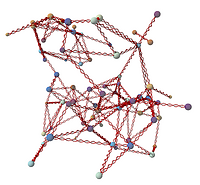 This week's blog on CNE Health was about how pharmaceutical companies use webcrawlers looking at patient sites to look for early warning for side effects. In particular, the iReputation from NetRank.
This week's blog on CNE Health was about how pharmaceutical companies use webcrawlers looking at patient sites to look for early warning for side effects. In particular, the iReputation from NetRank.
This is another example of how the net produces impressive synergies from the sheer amount of data and clever ways of compoling it. Doing it right and efficiently is another matter: just looking at keyword counts will not be able to distinguish real reports from spreading rumours or people citing each other. But that is something one can tweak.
What I find most interesting about the story is how unsettling many people find this. It is like publicly posting complaints, experiences and stories on a university bulletin board, and then be angered because the university faculty reads it and responds to what is written. Yes, the companies are for profit, but that is also that ensures that they will try to make medicines safe and sellable enough. But many tend to consider their online communities private by default, even when they are the exact opposite (imagine a place where everything you said will be timestamped and permanently recorded and searchable by anyone in the world forever).
I found this interesing apology which suggests that the original news report and its spyware slant scared a lot of people. Clearly much work remains for the companies to demonstrate that this crawling actually benefits patients and companies alike, and among patient organisations to realize the usefulness of this approach - especially since there is nothing to prevent them from running similar software.
I predict that within a few years, most patient groups, NGOs and interest groups have monitoring software running on the web, looking for evidence that something is emerging that requires them to look at. I just hope I get a chance to participate in writing and making money from it.
In the long run this kind of monitoring likely becomes a race when several groups want to score coup by finding a new correlation the fastest: if the patients find a side effect quicker, they put the pharma company on the defensive and may get concessions, if the pharma company finds it first it can quietely set up countermeasures to the side effect and then reveal a new and improved product.
June 17, 2005
Suffer No Evil in Academia?
Yesterday a group of Christian Democrat politicians warned against the ideas of the philosophy professor Torbjörn Tännsjö. They complain that his ethics contradicts human rights as defined by the UN, and urge society to not deal with his center for bioethics.
The sticking point is that Tännsjö is a fairly consistent hedonistic utilitarianist, a view that he often takes on a spin in the media with controversial but interesting comments. That doesn't sit to well with the position of the politicians, which seems to be partially derived from thomism and very sensitive to issues of human dignity. That they criticise his philosophy is only fair, but that they do it from their position as politicians is worrying. They clearly question the tax funding of the bioethics center, and urge government bodies not to listen to its views.
This is a serious acadmic freedom issue. It would of course have been worse if it was not an opposition party complaining (sometimes it seems the ruling social democrats behave like one of the sillier utilitarian thought experiments of Tännsjö), but clearly the government does influence what can be said and done in the largely state funded universitities of Sweden.
People often say that it is good that academic research is not funded by the private market, so it doesn't have to bend itself to its crass interests. But the same goes for the government and politics. There is a marked lack of Swedish political science that questions the current system, and researchers in everything from unemployment and environment issues mostly appear to suggest minor improvements of how things are done, rather than ever saying that it ought to be done differently. It is of course possible that we somehow have reached the optimal social state, but it seems more likely that people are simply reducing criticism in order to ensure continued funding. (c.f. Bo Rothstein's criticism of the growing political control of Swedish academia)
If we accept the position that one should not fund positions that one does not agree with, then the conclusion ought to be to remove tax-funding of theology departments (at least from us atheists), left-leaning social science departments (for rightwingers) and business schools (for marxists). I.e., these institutions should not be funded through taxes at all. One might especially question whether taxes should help fund political parties, as they are now.
It is unlikely that the christian democrats will silence Tännsjö as an individual researcher, since he seems to thrive on irritating them (and has become the most popularly well-known philosopher in Sweden thanks to this). And their suggestion that it was a good thing that he was passed over in a strange way for a professorship at the Karolinska Institute might not do him much harm. But it is far more worrying that they try to limit how other groups listen to his bioethics center. The center doesn't seem to hold utilitarianism as a core view, but is open to many different and not always popular views (c.f. the sports ethics conference). But it doesn't take much pressure for a muncipality pondering who to invite or what papers to place in a reading list to select some other source, especially if a local party politician takes a strong position against it.
That the attack bases itself on that Tännsjö's philosophy is counter to the UN declaration of human rights is also interesting. This is rhetoric to convince people not holding their views rather than a core ethical reason; the UN declaration is quite popular in Sweden, mostly because few have ever read it or tried to make philosophical sense of it. I could rant on for ages about how it conflates positive and negative rights, the statist assumptions and jpw its philosophical weakness ought to be obvious from the fact that it has been accepted by plenty of very nasty UN member nations. But doing a real philosophical attack on Tännsjö would require a more advanced debate: setting forward the christian democrat concept of human dignity, and then arguing that this form of human dignity is the right one and that alternative views such as Tännsjö's are morally inferior or even undermine what is right and good. Entirely doable (I know that at least one of the authors could do a good argument along this line), but a few lightyears beyond how Swedish public debate is done. Instead one invokes the sacred power of the UN, and everything is fine.
Article 18 states: "Everyone has the right to freedom of thought, conscience and religion; ... and freedom, either alone or in community with others and in public or private, to manifest his religion or belief in teaching, practice, worship and observance." Clearly this implies a right to teach utilitarianism.
June 15, 2005
Beauty is in the Decryption Power of the Beholder
 [physics/0505088] Aesthetics and scarcity. A physics perspective on ornament by Karl Svozil.
[physics/0505088] Aesthetics and scarcity. A physics perspective on ornament by Karl Svozil.
Does beauty have to have a natural element in order to truly appeal to us? This paper argues that human predispositions inevitably makes aesthetics based on natural forms. In my opinion it does not argue convincingly for this conclusion, but it is filled with good pictures and interesting references.
One assumption that seems plausible is the "law of decryption": we decrypt sensory patterns as a natural part of perception, and if it is too fast and easy we will become bored and if it is too difficult we will be perplexed and irritated. Random noise or monotone modernist architecture are easy to mentally model, a forest isn't - but it still makes sense, so it can be beautiful.
Is it just the information of the pattern (low in regular patterns, high in random ones) that matters? Clearly not. Is it the complexity of the generating process, as Svozil suggests? I find that hard to believe, since we do not find the patterns created by very complex organisms orders of magnitude more beautiful than the patterns of organisms orders of magnitude simpler. The genetic network of even a simple bacterium is beyond our perceptual and cognitive ability to parse. Beyond a fairly low point any generating process becomes mystery. But many generating processes still possess modularity enough for us to enjoy ynderstanding them on a phenomenal level. The Mount Everest or forest images in the paper consist of interleaved modules (trees, leaves, glaciers, rivers) that each can be understood and analysed, yet still form part of a greater whole. The processes behind a river shape or a tree still remain too complex to understand, but again we make use of our limited knowledge and construct a partial model that is "good enough". A deeper understanding produces a deeper sense of beauty since we can go deeper into the algorithm.
But this view suggests that it is not naturalness per se that we enjoy, but rather complex, deeply modular objects. Nature is better at creating them than humans, although I think we are getting there with things like Venice or the Internet.
In my opinion there are better arguments that naturalness speaks to us than arguments from information theory. We have co-evolved with our environment, and whatever use the sense of beauty has (if any; it could just be an accident of our mental architecture that is fitness-neutral) it seems unlikely that the baseline of how we perceive the beauty of the environment would evolve to be negative.
A simple explanation of beauty is that most things we find beautiful are survival-enhancing: just as we have an innate delight for sweet things (until we learn about calories) we have built-in preferences for things that helped us survive in ancestral environments. Just look at the most wanted paintings, and note how everybody but the Dutch want a lake with a tree and some hills. Access to water, food, shade and defense. These basic survival-enhancing detection systems have become extended to far more objects, activities and goals than originally, just as our working memory, planning abilities or sense of rhythm have gained new uses. This instrumentalistic view of beauty fits in with the view where art is seen as the process producing an artifact; "helping nature become more fully realized". Here the survival perspective becomes a project of teleology.
Of course, art might also be something entirely neutral. This is more akin to Scott McCloud's theory in Understanding Comics (ha! got another McCloud reference into my blog! Where will it stop?). Art is simply something we do because we can, and serves no particular purpose. It could of course produce new things that serve purposes or generate them in us, but art is basically for art's sake. Not sure I believe that explanation, but neutral evolution can do many strange things. I noticed a paper about Nabokov's theories on insect mimicry that argued that he was actually prefiguring neutral evolution. Maybe art is just an expression of biological exuberance, something utterly random and contingent.
A fun paper explored how flowers affect mood (they improve it, surprisingly enough). It points out that enjoyment of flowers does not seem to be culturally learned. Maybe flowers have actually evolved towards being strong positive emotion signals not just towards pollinating species but other species too? After all, it seems unlikely that we enjoy flowers so much because they told our ancestors a likely future food source; then we would enjoy verdant and healthy vegetation even more. The paper suggests that we are primed to easily learn the association flower-happiness because our brains happen to react well to their colors, shapes and scents, perhaps as super-stimuli.
This gets some support from the studies of Ghirlanda & Enquist and Bullock & Cliff of co-evolving visual systems and patterns. They found an evolution towards bright colors and symmetric patterns and networks good at detecting them. Flowers have evolved towards this goal very strongly, and we non-pollinators might simply react to them as supernormal stimuli to our perceptual systems. This might fit in nicely with the neuroaesthetics of Vilayanur S. Ramachandran. Still, that leaves much to be explained. For example, why do we experience harmony?
Anyway, to wrap things up, I think Svozil paper has some interesting points about how scarcity of resources caused the modernist anti-natural aesthetic. But I think his analysis about the beauty-poverty of economically poor people today doesn't work. His argument is that since real beauty is based on natural patterns it will require craftmanship, and that makes it too expensive for the lower classes. A poor person today may not afford fine parquet flooring, but he can certainly afford replicas. In fact, if one looks at a lower class home today one will find a tremendous amount of decorations, many of which are either natural or depict natural beauty. Popular "Hötorgskonst" often depict scenes of great natural beauty - but is deeply devalued by aesthetes because of its "cheap thrills". But maybe this is more because aesthetes develop a refined aesthetics to separate themselves from the masses? If everybody enjoys it, it isn't fine art.
One can of course make a case that high art is art that stimulates higher cognitive processes than art that merely delights the lower visual system. High beauty would be beauty with layers of meaning (requiring decryption), while low beauty just stimulates the right pattern detectors. This of course ensures that the aesthetes, who spend much time cogitating on beauty, will be the experts on high beauty while the hoi polloi will at best be amateurs and creators of low beauty. There is some truth in this; quite a few people lack taste, which means they combine individually beautiful elements into a larger picture that lacks cohesion. The underlying pattern becomes merely random, rather than some integral logic determining what goes where. But this has little to do with lack of resources.
Svozil makes a good point about virtual environments needing more naturalness to be worth interacting and living in. Today we place dirt in the corners of photorealistic images by hand; we need software that allows us to simulate environments that have been subjected to virtual weather and being lived in (maybe by having agents do the living, spreading dirt by walking, dropping and picking up papers and objects etc). An environment that lacks this lacks the multisensory history of a real environment, and our brains immediately get bored. It is not enough to place it randomly, there has to be the hidden patterns that allow our cortical Sherlock Holmes to deduce how people have moved in a room or what kind of activity had occured on the desk before. Maybe the first step to a truly useful windowing system is to add dirt?
June 04, 2005
Book Challenge
![]() Right now a challenge is circulating in the Swedish blogosphere about books. I was challenged by Waldemar Ingdahl. While this kind of chain- activities should always be viewed with suspicion, this is at least somewhat constructive. Perhaps someone can set up a crawler to map this social network and the book preferences.
Right now a challenge is circulating in the Swedish blogosphere about books. I was challenged by Waldemar Ingdahl. While this kind of chain- activities should always be viewed with suspicion, this is at least somewhat constructive. Perhaps someone can set up a crawler to map this social network and the book preferences.
1. How many books do you own?
On the order of 2000, give or take those who are on indefinite loan to friends, hidden in cellars, hidden in my paper piles or in transit to me at present. Given the floorspace in my flat, that is 70 books/square meter if they had all been here.
2. Latest book purchase?
A visit to an used bookstore recently provided History of the Breast by Marilyn Yalom and Makt som Hobby ("Power as a Hobby") by Tõnis tõnisson. The breast book was a mother's day present for my dear mother, the power book to replace a lost copy. Tõnissons book is a classic reference work in manipulation, mental self-defense and ambition.
The latest new book I bought was Visions of Technology: Machines, Systems and the Human World by Richard Rhodes.
3. Latest book you read?
Zenith Angle by Bruce Sterling. A Candide-meets-Bruce Schneier story about computer security in the post-911 world and how standard politics makes security imposslbe.
4. Five books that has meant a lot to you (which you have read at least three times)
The Anthropic Cosmological Principle by Barrow and Tipler. This was the book that taught me to think big. It showed that there might be a chance for intelligence to change the way the universe worked, suggesting the ultimate ambition: cosmological engineering of an omega point.
Bråkmakarna by Ulf Nilsson. A collection of troublemakers from across history, from Alkibiades and Socrates to John McEnroe and Ralph Nader. Others might grow up with biographies praising heroes; this one drew out all their bad sides and yet managed to show that these ambitious but human characters were larger than life.
Journey to the West. I first saw the classic 1960's Chinese cartoon of the story of the Monkey King as a young kid, and he has stayed with me ever since. To me the Monkey King is humanity (or perhaps, the proper god of humanity): self-creating, self-transforming, a stupid sage, a tenacious drunk, wildly ambitious and always ignoring boundaries. Even in the Buddhist framework of the epic he gets away with being both a bodhisattva, taoist immortal and annoying monkey.
Watchmen by Alan Moore and Dave Gibbons. Probably the most impressively structured novel I have ever read. It is like a piece of crystaline spacetime, possible to read from any direction. Every piece interlocks with everything else, and even succeeds in depicting a posthuman perspective. It is the Gödel, Escher, Bach of graphical novels.
Envisioning Information by Edward Tufte. One of the most beautiful books I own. This is the beauty of clear exposition, information as art and the sheer pleasure of understanding.
Some other books that ought to be on the list but failed for cardinality reasons: Neverness by David Zindell, The Future and its Enemies by Virginia Postrel, Framtidens Byggstenar by Frederic Vester, Gödel, Escher, Bach by Douglas Hofstadter, Understanding Comics by Scott McCloud.
5. Five bloggers that I would like to see responding to these questions.
Lene Johansen, Greg Burch, Malin Sandström, George P. Dvorsky and Nicklas Lundblad - who of course had been reached by this challenge long before. And as he said, he is the point where all chain mails stop. So does this.
The top image was made with Amaztype.
June 03, 2005
Where the Streets have no Tags
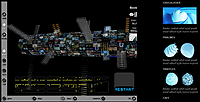 INFOTUBE is a virtual visualisation of a japanese shopping street. (from Information Aesthetics)
INFOTUBE is a virtual visualisation of a japanese shopping street. (from Information Aesthetics)
One can fly around and browse the stores, see mappings between goods and where they can be bought on the real street, as well as entirely virtual information such as visit popularity (as measured by the branches from the tube).
This is a cool web application, but it smells of early 90's virtuality. Part of it is the aesthetics of icons hanging in the blackness of cyberspace along geometric patterns. But there is a deeper problem here, the attempt itself to map a physical street into a virtual environment.
The tube application is so similar to how I would have gone about this a few years back that it annoys me. I do not pretend that I have matured, but I have become a more active shopper than in my early student days.
The researchers make a good background case why browsing the tube is more similar to a real shopping experience than browsing a website. But do I want a traditional shopping experience when shopping from my computer? Some aspects such as serendipitous finds and social interaction might be desirable, but seeing clothes stores when I am more in the mood for a chocolatiér does not help me. Amazon is busy enough as a website and provides me with far more accurate temptations. Online shopping has far broader potential than just producing a virtual arcade.
Part of the problem is that this is a project about envisioning the future of Motomachi Shopping Street, and hence it is intimately tied to the physical street. The proposal even suggests adding terminals to the street allowing one to explore it through the tube. Nice, but wouldn't just a digital map pointing out where everything is do the same job? I think the basic technique used in the infotube might be useful for some visualisations (selecting television channels? comparing visual styles depicted in the icons?) but that it is dragged down by trying to link to the shops on the street.
The core problem is in my opinion that it starts with a physical street with certain stores and creates a virtual replica, assuming that somebody who would like to use the physical street would like to use the tube, or vice versa. But there is no reason for the stores in the tube to correspond to a stores in a single street. Just as there was a tinkerer alley, cobbler's lane and jeweller street in a medieval city one could put all the chocolatiérs in Yokohama (or the world) on the same virtual tube where one could browse. Other products could exist in their own tubes, perhaps individually filtered and mixed together. After all, I might make the distinction between chocolatiérs and candy stores, while to another user these belong together. Based on our individual tag ontologies the right kind of tube could be created.
Meanwhile, on the real street: here the enhanced shopping experience would be the ability to call up digital information about objects, stores and prices. If I see something I like, I would like to compare prices, maybe see reviews and related items - or not. A key point is to make these interfaces optional. I think an augmented reality system could do the job nicely: maybe one picks up cheap (maybe disposable plastic electronic) AR-glasses at the entrance of the street. These glasses react to optical tags on objects and stores, calling up their web pages. One could likely do the same with mobile phones; they should be reaching the level where they can react to optical tags about now.
For added trust (and hence sales!), allow general googling based on these tags - nobody would trust or like a system that just told the consumer the official truth of the sales force. If the street allows you to examine everything according to your own tastes, you are going to trust it better.
As I see it, future shopping will be about a careful balance between enticing customers by attention-sucking imagery and driving them away with visual spam, giving them market information but also the option to disregard or test it, creating personalised experiences and something shared that is externally created that is not expected. There will be different kinds of shopping and shoppers.
Finally, is it just me, or doesn't chocolate look better a brown rather than electric blue?
June 02, 2005
Images of THE Future

Tales of Future Past is a sharp depiction of the Predictable Future: "It wasn't that long ago that we had a future. I mean, we have one now; the world isn't going to crash into the Sun or anything like that. What I mean is that we had a future that we could clearly imagine. The future wasn't tomorrow, next week, next year, or next century. It was a place with a form, a structure, a style."
This modernist vision of the Future is long past, but we still come back to it for its childhood (or antique) charm, or more worryingly, because it remains one of stability and imaginability. It is the present but better, rid of the pesky problems of the human condition. Even the different utopias and dystopias are firmly rooted in this ordered future, ready to be brought out when needed in a present debate.
Because in the postmodern world the future has become so complex, unpredictable and maybe messily human that it won't do. There is no single future that history must take, and most of the possibilities are either impossible or hard to imagine. The singularity is already upon us!
The result is a fear of chaos. Because to most people unpredictability is not just irritating lack of knowledge, but a real threat - anything could happen, and since most events are bad, it is likely that the unpredictable hides horrific dangers. In the modernist mindset control was possible and the solution. But if control is not possible, then the sea of chaos comes rushing in. A picture not unlike the waters of Nun held back by the law of Maat in Egyptian mythology. This fear of lack of control is probably a human universal, something we tend to return to when not reassured of other possibilities.
Because after all the world does not crash because nobody is in charge. Markets, computer networks, ecologies, evoloution and social networks manage just fine (with occasional bumps). They still (at least the human institutions) require certain core support like the rule of law, people solving problems or people desiring to keep connected to each other, but they do not need a central planner deciding how it all should work. Accepting self-organisation, whether as taoism or liberalism, requires more faith (hopefully supported by insight and observation) than believing in the need for the Great Engineer.
This dynamist conception of an open, self-organising future doesn't preclude us from influencing it. We can influence even if we do not control. We can look among the many possibilities, try those we think work and select those that actually works and build on them. But to do this we need to be better at envisioning futures. But far too often the futures envisioned are the futures past, slightly updated. We need to become better at coming up with instant futures, creating mental scenarios rapidly and playing around with them. This is why I play roleplaying games.
